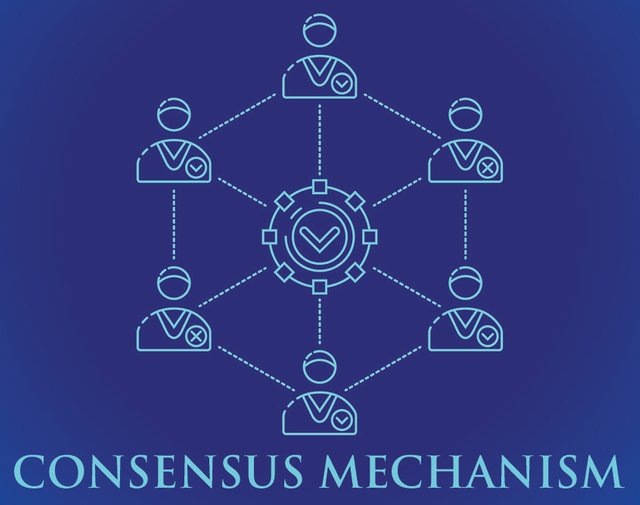Crypto Academy Season 3 Beginners' course - Task 4: Different types of Consensus Mechanisms by @phlexygee
Hi steemians,
Today marks my fourth beginner task course in this renowned academy and I will probably be tackling the first question which is just beneath.
(1) What is the difference between PoW & PoS? Advantages & Disadvantages? Which one is better in scaling Capacity? Examples?
Consensus Mechanism:
The ultimate aim is to ensure the security and verification of blockchain transactions.
Below are some variety of Consensus Mechanisms:
- Proof-of-Work (PoW)
- Proof-of-Stake (PoS)
- Proof-of-Burn (PoB)
- Proof-of-Capacity (PoC)
- Delegated-Proof-of-Stake (DPoS)
I will be pondering on the first two which are PoW and PoS respectively.
Proof-of-Work
As the name suggest, Proof of Work is about the miners proofing their mathematical puzzle solving skills through competing with each other on a requested blockchain transactions to claim rewards for their efforts.
The miner who solves the mathematical problem or puzzle early among his peers becomes the winner and share the newly created block with the other colleagues (nodes) and receive some proportional amount of reward.
Proof-of-work was the first consensus mechanism introduced with the aim of creating new blocks and verifying transactions.
Differences between Proof-of-work and Proof-of-Stake:
| Proof-of-Work | Proof-of-Stake |
|---|---|
| Firstly introduced | Secondly introduced |
| Requires solving of maths puzzle | No puzzle solution is required |
| High energy consumption | Low energy consumption |
| Expensive | Less expensive |
| There exist miners | There exist validators |
| Low scalability capacity | High scalability capacity |
Merits of Proof-of-Work
High level of security; It is much expensive for an attacker to venture because an attacker need to take control of about 51% of the total nodes power which is less possible to happen, even if it does there will be a lost rather than a win on the part of the attacker due to the resources required. The involvement of the mathematical puzzle serve as a headache to attackers because it is very complicated to solve.
Rewards; the miners gain some proportion of rewards for their mining efforts.
It brings about a better degree of decentralized network which satisfy the idea of blockchain and Crypto-currencies.
Demerits of Proof-of-work
Expensive; it is more expensive because it requires a high performance computer together with other peripherals for its operations which comes at a higher cost.
There is low scalability capacity.
Transactions are being delayed as a result of the puzzle and calculations.
High energy consumption.
Proof-of-Stake
The emergence of Proof-of-Stake took place as an intervention to curb the challenges that where associated with the Proof-of-work such as high power consumption, low scalability etc.
Merits of Proof-of-Stake
Less expensive.
High scalability capacity.
Fast transactions.
High gains for high stakes.
Demerits of Proof-of-Stake
There is high level of insecurity which paves way for hackers.
There is a sense of centralization and It encourages the rich to be richer by giving them more influence over the less privileged.
There is a higher chance of incompetence validators due to the recruitment criterion.
Scaling Capacity:
The ability of a system (computer) to maintain its functions without any defects after a change in size or volume of data.
In the crypto world I will define it as the processing rate of crypto currency transactions at a time ( the ability to meet and control transaction demand without further challenges).
After reading through the slides and doing a thorough independent research, it stands clear that the Proof-of-stake has a higher or better scaling Capacity due to technological advancement and the absence of mathemathetical puzzle problems before transactions are made.
Therefore I will submit that the Proof-of-Stake has the better scaling capacity.
Examples of Proof-of-Stake tokens are:
BNB; it is the native coin of popular exchange Binance and a staker can earn about 30%.
Flow Token; it is an independent Layer 1 blockchain for games and NFT.
Raydium (RAY); it is an automated market maker on Solana platforms and there is a chance to earn up to 50% APR.
DASH; also known as digital cash and it is one of the pioneers that adopted the Proof-of-Stake mechanism at the early stage of its introduction.
NAV Coin; it has two different blockchains for private transactions. It has been operating since 2014 on Bitcoin's core code.
Cardano; It is also a public blockchain platform which deals with the Proof-of-Stake consensus mechanism.
The are approximately several Proof-of-Stake Tokens out there of which I can't mention all.
Conclusion:
Initially I assumed the whole concept of consensus mechanism was complicated untill I took my time to read and understand then I got a better view of the concept.
It is good to employ reliable measures that will at least ensure the safeness of blockchain transactions and I think blockchain and software developers are on the right move by introducing such systems.
